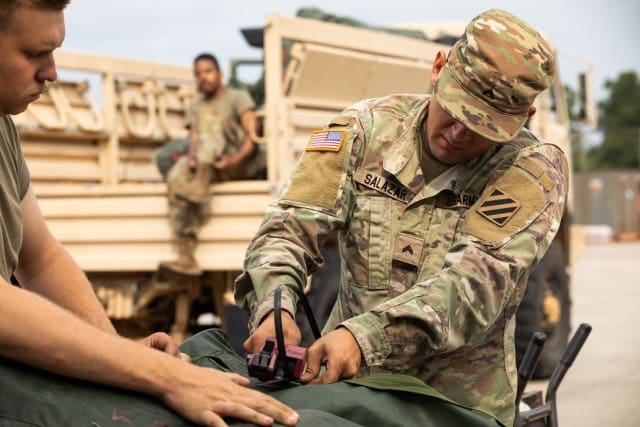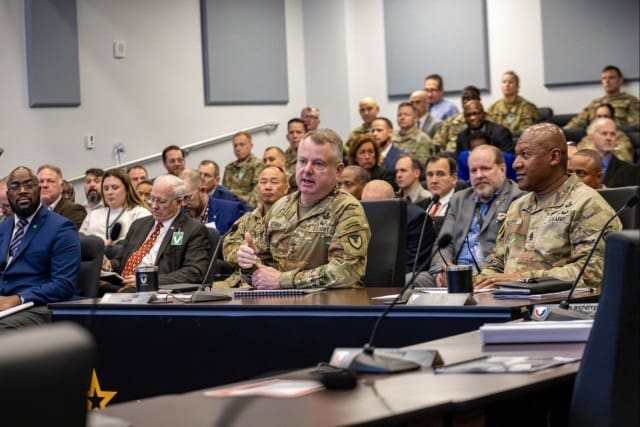REDSTONE ARSENAL, Ala. – As the Army pushes forward with its modernization agenda, the Army Modernization and Equipping Conference provided the sustainment enterprise a critical opportunity for leaders to align efforts, prioritize resources and drive momentum behind the equipment initiatives that will shape the Army’s future.
The conference, held at Redstone Arsenal Dec. 9-12, 2024, serves as a semi-annual opportunity for equipping stakeholders to review, confirm and plan equipment displacement over the next three fiscal years.
“The solutions to the problems we are going to talk about this week will help us maintain combat power in an Army that’s tier modernized,” said Lt. Gen. Chris Mohan, deputy commanding general and acting commander of Army Materiel Command. “We can’t be afraid to try and do something different to help our units.”
The AMEC kicked off with opening remarks from leaders at AMC; U.S. Army Forces Command; the Assistant Secretary of the Army for Acquisition, Logistics, and Technology; and Training and Doctrine Command. Attendees were briefed on updates to a variety of initiatives impacting equipping, including Rapid Removal of Excess, an update on equipment cascade process, an overview on the Operational Readiness Program, and a preview of changes coming to demand planning prediction.

“The magnitude of change the world is facing is staggering,” said Lt. Gen. Stephen Smith, deputy commanding general of FORSCOM. During his opening remarks, he emphasized that his focus for the conference was to support 2-year-out supply and equipping predictability for company commanders who need to concentrate on building and maintaining their unit’s readiness.
One year since the kickoff of the R2E pilot program, leaders at the AMEC agreed that it has been a vital addition to the Army’s divestiture efforts. More than 435,000 pieces of equipment — ranging from tactical vehicles to computer monitors and printers — have been collected at the Army’s 14 Modernization Displacement and Repair Sites alone since October 2023.
Earlier this year, R2E became a global program available to Soldiers of all components at each Army installation.
“We want every Soldier to have the opportunity to participate in R2E, but more importantly, we want their units to take steps to prevent needing to use R2E again,” Mohan said.
With hundreds of thousands of pieces of equipment on their hands, AMC’s R2E team’s next step is to determine what needs to be repaired, disposed or demilitarized; if they can harvest parts from turned in equipment; the cost and timeline for repair; and their plan to prioritize these efforts.
AMC turned over the floor to Tank-automotive and Armaments Command for a brief on ORP, a new initiative aimed at ensuring units have the highest level of operational readiness as they leave training rotations to head into deployment. The process flow starts with using data and analytics to predict equipment that will fail while units are training; then AMC will send experts from the Organic Industrial Base, called fly-away teams, to both fix equipment and train Soldiers how to better maintain it.
“There’s a lot on the shoulders of our young maintenance Soldiers to keep their unit’s equipment ready,” Mohan said. “Our fly-away teams and the ORP algorithm are informing the future of maintenance and how we will fight and win wars.”

Leaders from FORSCOM also emphasized that commanders appreciate the extra hands for repair, but the training that the fly-away teams provide is invaluable. Although it’s a new initiative, data has shown that participating units have held steady operational readiness since ORP began.
AMC plans to use data collected from ORP to better inform Class IX equipment demand planning, a concept briefed to AMEC attendees by AMC’s Supply Chain Management Division.
In the past, the Army has forecasted equipment demand using only historical data. Between the COVID-19 pandemic, a surge in operations and presidential drawdowns for support to Ukraine and an increase in operation tempo, supply chain vulnerabilities were exposed.
The Army has implemented a variety of solutions aimed at reducing lead time of equipment and better predicting demand. Recently, a demand planning workshop was held with action officers from across the Army sustainment enterprise to develop an all-encompassing model that predicts demand and incorporates equipment cascading as determined by the AMEC.
“We’re taking a wholesale approach to this change in supply availability,” said Mohan.
AMC plans to use artificial intelligence and machine learning, as well as historical data and input from unit commanders and supply Soldiers to predict demand of Class IX parts moving forward. Another workshop will be held in the new year aimed at presenting current findings and refining the existing concept.
Day two of the AMEC saw attendees dive deep into the nuances of equipment cascade of tactical vehicles while days three and four had attendees organized into breakout groups on equipping and Transform in Contact activities.
This iteration of the AMEC had the largest number of participants from the most commands and equipping stakeholders across the Army to date – an indicator to senior leaders of the importance of maintaining momentum toward solutions to rising equipping problems across the total force.
“What I see today is that we are making incredible progress on solving these problems across the Army,” said Lt. Gen. Robert Collins, principal military deputy to ASA ALT and director of the Army Acquisition Corps. “It’s more important than ever that we stay synced.”
By Lindsay Grant

